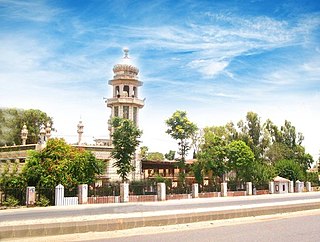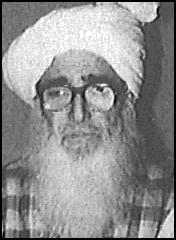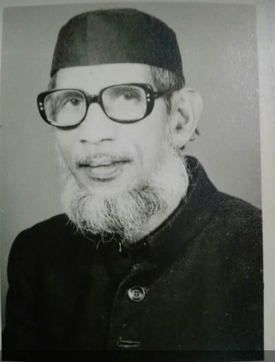
The Deobandi movement or Deobandism is a revivalist movement within Sunni Islam that adheres to the Hanafi school of law. It formed in the late 19th century around the Darul Uloom Madrassa in Deoband, India, from which the name derives, by Muhammad Qasim Nanautavi, Rashid Ahmad Gangohi, and several others, after the Indian Rebellion of 1857–58. They opposed influence of non-Muslim cultures on the Muslim of South Asia. The movement pioneered education in religious sciences through the Dars-i-Nizami associated with the Lucknow-based ulama of Firangi Mahal with the goal of preserving traditional Islamic teachings from the influx of modernist, secular ideas during British colonial rule. The Deobandi movement's Indian clerical wing, Jamiat Ulema-e-Hind, was founded in 1919 and played a major role in the Indian independence movement through its participation in the Pan-Islamist Khilafat movement and propagation of the doctrine of composite nationalism.

The Darul Uloom Deoband is an Islamic seminary in India at which the Sunni Deobandi Islamic movement began. Uttar Pradesh-based Darul Uloom is one of the most important Islamic seminaries in India and the largest in the world. It is located in Deoband, a town in Saharanpur district, Uttar Pradesh. The seminary was established by Muhammad Qasim Nanautavi, Fazlur Rahman Usmani, Sayyid Muhammad Abid and others in 1866. Mahmud Deobandi was the first teacher and Mahmud Hasan Deobandi was the first student.
Muhammad Rafi Usmani was a Pakistani Muslim scholar, jurist and author who served as the President of Darul Uloom Karachi. He was an alumnus of Darul Uloom Deoband, University of the Punjab and the Darul Uloom Karachi. He authored books including Ahkām-e-Zakāt, Al-Tālīqāt al-nāfi'ah alā fath al-mulhim, Islām mai aurat ki hukmrāni and Nawādir al-Fiqh. He was a syndicate member of the University of Karachi, vice-president and a member of the executive council of Wifaq-ul-Madaris. His brother Muhammad Taqi Usmani is also a senior scholar.

Mufti Mehmood was a Pakistani statesman and Islamic scholar who was one of the founding members of the Jamiat Ulema-e-Islam (JUI); widely regarded as one of the greatest politicians in the history of Pakistan - known for his political acumen. He served as the first elected Chief Minister of Khyber Pakhtunkhwa, and later on as the Leader of the Opposition in National Assembly. He led the opposition movement Pakistan National Alliance against Zulfiqar Ali Bhutto, which eventually led to Bhutto's downfall. He was among the principal architects of the 1973 Constitution of Pakistan.

Ubaidullah Sindhi was a political activist of the Indian independence movement and one of its vigorous leaders. According to Dawn, Karachi, Maulana Ubaidullah Sindhi struggled for the independence of British India and for an exploitation-free society in India. He was also Home Minister of first Provisional Government of India established in Afghanistan in 1915.

Mahmud Hasan Deobandi was an Indian Muslim scholar and an activist of the Indian independence movement, who co-founded the Jamia Millia Islamia University and launched the Silk Letter Movement for the freedom of India. He was the first student to study at the Darul Uloom Deoband seminary. His teachers included Muhammad Qasim Nanawtawi and Mahmud Deobandi, and he was authorized in Sufism by Imdadullah Muhajir Makki and Rashid Ahmad Gangohi.

Muhammad Qasim Nanawtawi was an Indian Sunni Hanafi Maturidi Islamic Scholar, theologian and a Sufi who was one of the main founders of the Deobandi Movement, starting from the Darul Uloom Deoband.
Jamia Uloom-ul-Islamia is an Islamic University in Banoori Town, Karachi, Pakistan. The university continues the tradition of the Darul Uloom system initiated by Darul Uloom Deoband. As of 2007, there are about twelve thousand students in different departments of the Jamiah and its branches, including a number of foreign students from over sixty countries.

Darul Uloom Haqqania or Jamia Dar al-Ulum Haqqania is an Islamic Seminary in the town of Akora Khattak, Khyber Pakhtunkhwa province, northwestern Pakistan. The seminary propagates the Hanafi Deobandi school of Sunni Islam. It was founded by Maulana Abdul Haq along the lines of the Darul Uloom Deoband seminary in India, where he had taught. It has been dubbed the "University of Jihad" due to its methods and content of instruction, along with the future occupations of its alumni. A number of leading members of the Taliban, including past chief Akhtar Mansour, studied here.
Muhammad Yaqub Nanautawi (1833–1884) was an Indian Islamic scholar, and one of the earliest teachers of Islamic Madrassa in Deoband, famously called Darul Uloom Deoband in India. He was the first principal of Darul Uloom Deoband.

Abdul Haq, also known as Abdul Haq Akorwi was a Pakistani Deobandi Islamic scholar and the founder, chancellor, and Shaykh al-Hadith of the Islamic seminary Darul Uloom Haqqania. He also served as vice-president of Wifaq ul Madaris Al-Arabia, Pakistan. He was involved in politics as a member of the political party Jamiat Ulema-e-Islam. He served three times in the National Assembly of Pakistan and was an active proponent of the Khatme Nabuwwat movement.

Muhammad Mian Mansoor Ansari, was a leader and a political activist of the Indian independence movement. He was a grandson of Muhammad Qasim Nanautavi, one of the founders of Darul Uloom Deoband in 1868. Along with Mahmud Hasan Deobandi, he was one of the pioneer of the Silk Letter movement against British Raj.

Nizāmuddīn Asīr Adrawi was an Indian Sunni Muslim scholar, biographer, historian and author in the Urdu language. He established Madrassa Darus Salam in Adari and served as Officer In Charge of Jamiat Ulama-e-Hind in Lucknow from 1974 to 1978.
Hafiz Muhammad Ahmad (1862–1928) was an Indian Muslim scholar, who served as the Vice Chancellor of the Darul Uloom Deoband for thirty five years. He was the Grand Mufti of the Hyderabad State from 1922 to 1925.

This bibliography of Deobandi Movement is a selected list of generally available scholarly resources related to Deobandi Movement, a revivalist movement within Sunni Islam, adhering to the Hanafi school of law, formed in the late 19th century around the Darul Uloom Deoband in British India, from which the name derives, by Qasim Nanawtawi, Rashid Ahmad Gangohi and several others, after the Indian Rebellion of 1857–58. It is one of the most influential reform movements in modern Islam. Islamic Revival in British India by Barbara D. Metcalf was the first major monograph specifically devoted to the institutional and intellectual history of this movement. Muhammad Tayyib Qasmi wrote a book named The Tradition of the Scholars of Deoband: Maslak Ulama-i-Deoband, a primary source on the contours of Deobandi ideology. In this work, he tried to project Deoband as an ideology of moderation that is a composite of various knowledge traditions in Islam. This list will include Books and theses written on Deobandi Movement and articles published about this movement in various journals, newspapers, encyclopedias, seminars, websites etc. in APA style. Only bibliography related to Deobandi Movement will be included here, for Darul Uloom Deoband, see Bibliography of Darul Uloom Deoband.

This bibliography of Darul Uloom Deoband is a selected list of generally available scholarly resources related to Darul Uloom Deoband, a leading Islamic seminary and Muslim theological centre in India at which the Deobandi movement began, founded in 1866. It is one of the most influential reform movements in modern Islam. It created a largest network of satellite madrasas all over the world especially India, Bangladesh, Pakistan, Afghanistan neighboring countries in Asia and beyond, and as far afield as the Caribbean, South Africa, United Kingdom and the United States. Islamic Revival in British India by Barbara D. Metcalf was the first major monograph specifically devoted to the institutional and intellectual history of Deoband. Syed Mehboob Rizwi wrote History of Darul Uloom Deoband in 1977 in 2 volumes. This list will include Books and theses written on Darul Uloom Deoband and articles published about Deoband in various journals, newspapers, encyclopedias, seminars, websites etc. in APA style. Only bibliography related to Darul Uloom Deoband will be included here, for Deobandi movement, see Bibliography of Deobandi Movement.
The Deoband–Aligarh relationship refers to the historical and ideological tensions that existed between the Deobandi and Aligarh movements in British India during the late 19th and early 20th centuries. Darul Uloom Deoband and Aligarh Muslim University are two influential Islamic educational institutions in India that have played significant roles in the country's history. Darul Uloom Deoband is a conservative Sunni Islamic seminary that was founded in 1866 and has focused on traditional Islamic learning and the promotion of Islamic values and practices. Aligarh Muslim University, primarily Muhammadan Anglo-Oriental College, on the other hand, is a modernist Islamic institution that was founded in 1875 and has focused on modern education and the promotion of rationalism, science, and social reform. The relationship between Deoband and Aligarh has been complex and has often been marked by tensions and disagreements.

Deobandi fiqh is a school of Islamic jurisprudence that is based on the Hanafi school of Islamic law. It is associated with the Deobandi movement, which originated in India in the late 19th century and has since spread to other parts of the world, particularly in South Asia. Deobandi fiqh emphasizes a strict adherence to the Quran and the Sunnah, and seeks to ensure that all aspects of daily life are guided by Islamic law. It places a strong emphasis on the principles of fiqh, or Islamic jurisprudence, and is known for its strict interpretation of Islamic law. It also emphasizes the importance of Islamic ethics and morality, and emphasizes the need for Muslims to lead a pious and virtuous life. Deobandi fiqh has had a significant influence on Islamic education and scholarship, particularly in South Asia and among the global South Asian diaspora. It plays a foundational role in the judiciary of Afghanistan. It has also been associated with various Islamic political movements and has been a subject of controversy and debate within the Muslim community.

Deobandi politics refers to a political phenomenon that originated during the 1857 Indian Rebellion in British India. Its primary objective is to establish Sharia law in various parts of the world, with a particular focus on South Asia. The movement is associated with the promotion of a conservative and orthodox interpretation of Islam that emphasizes strict adherence to Islamic law and tradition, and frequently concentrates on moral and social issues, such as the promotion of Islamic education and the defense of traditional values. The Deobandi movement has not adopted a singular model to achieve its objectives and has utilized both militant struggle and mainstream politics. Deobandi politics has undergone three waves of armed struggle, which can be identified as Deobandi jihadism. The first two waves failed, but the third wave resulted in the establishment of an Islamic state named the Islamic Emirates of Afghanistan. During the second wave of armed struggle, Mahmud Hasan Deobandi attempted to defeat the British in India with the assistance of the Ottoman Empire. However, his attempt failed, and he was arrested by the British. After his release, he and his disciples engaged in mainstream politics and were associated with the creation of political parties and social movements, such as the Jamiat Ulema-e-Hind. During the Indian freedom struggle, the Jamiat Ulema-e-Hind evolved and embraced composite nationalism, rejecting the partition of India as the better future for Indian Muslims. Nevertheless, other Deobandis refused to accept this and developed Muslim nationalism against composite nationalism, establishing the Jamiat Ulema-e-Islam to support the creation of Pakistan.

















